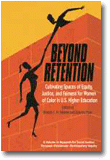
Beyond Retention
Cultivating Spaces of Equity, Justice, and Fairness for Women of Color in U.S. Higher Education
Edited by:
Brenda L. H. Marina, Baltimore City Community College
Sabrina N. Ross, Georgia Southern University
A volume in the series: Research for Social Justice: Personal~Passionate~Participatory Inquiry. Editor(s): Ming Fang He, Georgia Southern University. JoAnn Phillion, Purdue University.
Published 2016
In Beyond Retention: Cultivating Spaces of Equity, Fairness, and Justice for Women of Color in U.S. Higher Education, Brenda Marina and Sabrina N. Ross address the continued underrepresentation of women faculty of color at predominantly White colleges and universities through a creative convergence of scholarship focused on intellectual activism and structural change. Inspired by the African American oral tradition of call and response, this text illuminates the calls, or personal narratives of women faculty of color who identify racialized, gendered, sexualized, and class-based challenges associated with work in predominantly White institutions. Accounts of social justice-oriented strategies, policies, and practices that support women faculty of color and reflections by women of color who are senior faculty members serve as literal and metaphorical responses. The convergence of calls for social justice and equity-minded responses and reflections in this text provide intellectual foundations for the development of higher education spaces where women faculty of color can thrive.
Beyond Retention is a critical geographic project intended to identify and mitigate structures of oppression that act as barriers to the full incorporation of women of color in predominantly White academic contexts. This text will be of interest to scholars interested in curriculum topics of race, gender, sexuality, and place. The text offers strategies for coping and success for women of color in doctoral programs, faculty positions, and mid-level administration positions within the academy; as such, Beyond Retention will be a valuable addition to the reading libraries of each of these groups. Men and women with interests in the experiences of educators of color within predominantly White contexts will also gain valuable insights from this book, as will individuals interested in various areas of women studies, multicultural education, and diversity.
Beyond Retention also provides accounts of practices and policies that have been successful in supporting the needs of women faculty of color; knowledge gained from this text will be useful for higher education administrators seeking to improve the campus climate for faculty of color. Additionally, human resource directors, equal opportunity specialists and diversity trainers will find this text helpful when considering strategies for managing diversity.
CONTENTS
Series Foreword. Foreword, Sheila T. Gregory. Acknowledgments. INTRODUCTION: Where Do We Begin? Brenda L. H. Marina and Sabrina N. Ross. SECTION I: SURVEYING THE LANDSCAPE: Ripple Effects and Shock Waves: The Impact of a Black Female Faculty Member’s Open Letter to Her Institution, JeffriAnne Wilder. RESPONSE: Courageous Actions: A Response to Ripple Effects and Shock Waves, Elena Flores. Walking the Tightrope of Academe With No Net, Michelle D. Smith. RESPONSE: Lengthening Your Stride: Finding the Right Balance on the Tightrope, Patricia A. Mitchell. SECTION II: LOCATING SAFE SPACES: I’d Rather Be Harriet: A Counterstory of Two Sister Scholars, Nadrea R. Njoku and Juhanna N. Rogers. RESPONSE: Talking Back, Donyell Roseboro. Preparing to Lead: The Socialization of Black Women for Faculty and Administrative Careers Through Graduate School, Jennifer M. Johnson, Tykeia N. Robinson, Candice L. Staples, and Nina Daoud. RESPONSE: I Wish I Knew Then, What I Know Now: How to Build a Communal Pipeline, Tara T. Green. SECTION III: BLURRING BOUNDARIES AND TROUBLING INTERSECTIONS: Soy Latina, Donde Estas Mi Gente? Yvania Garcia-Pusateri. RESPONSE: Mentoring and Encouraging Professional Development for Latinas and Other Women of Color, Ramona Ortega-Listen. Triple Threat: Multiple Identities in the Academy, Lakeisha Meyer. RESPONSE: Commonalities, Contrasts, Challenges, and Commitments, Nina Asher. SECTION IV: GEOGRAPHIES OF SILENCE AND VOICE: Who Speaks for Me? Learning to Resist With Marginalized Statuses in the Academy, Jenelle Pitt. RESPONSE: Change Agents in the Academy: On Safe Spaces, Meaningful Advocacy, and Naming the Leak in the Academic Pipeline, Carol Henderson. Putting an End to Outside Looking In: It’s Time for Women of Color in Higher Education to Create Social Capital, Monica Burke. RESPONSE: We Cannot Do it Alone, Stacey Pearson-Wharton. SECTION V: CULTIVATING HOMEPLACE: Balancing the Call to Serve: The Costs and Benefits of Leaving a Legacy in the Academy, Tamara Bertrand Jones, La’Tara Osborne-Lampkin, and JeffriAnne Wilder. Expressing Civic Virtue Inside a Crooked Room: A Call to Awareness for Women of Color at Predominantly White Institutions, Mahauganee Dawn Shaw. Answer the Call, Brenda L. H. Marina. Where Do We Go From Here: Concluding Emerging Thoughts, Sabrina N. Ross and Brenda L. H. Marina. About the Contributors. Subject Index.
-
Paperback9781681234144
Web price: $45.04 (Reg. 52.99)
-
Hardcover9781681234151
Web price: $80.74 (Reg. 94.99)
- eBook9781681234168

- EDU054000 - EDUCATION: Urban
- EDU000000 - EDUCATION: General
- EDU001030 - EDUCATION: ADMINISTRATION: Higher
-
 (Un)Learning to Teach Through Intercultural Professional Development
(Un)Learning to Teach Through Intercultural Professional Development
-
 A Reader of Narrative and Critical Lenses on Intercultural Teaching and Learning
A Reader of Narrative and Critical Lenses on Intercultural Teaching and Learning
-
 Culturally Responsive Pedagogy
Promising Practices for African American Male Students
Culturally Responsive Pedagogy
Promising Practices for African American Male Students
-
 Indigenizing Education
Transformative Research, Theories, and Praxis
Indigenizing Education
Transformative Research, Theories, and Praxis
-
 Queer Multicultural Social Justice Education
Curriculum (and Identity) Development Through Performance
Queer Multicultural Social Justice Education
Curriculum (and Identity) Development Through Performance
-
 Struggling to Find Our Way
Rural Educators’ Experiences Working With and Caring for Latinx Students
Struggling to Find Our Way
Rural Educators’ Experiences Working With and Caring for Latinx Students
-
 The Blab of the Paved
"Bad Kids" and the School They Called Family
The Blab of the Paved
"Bad Kids" and the School They Called Family

